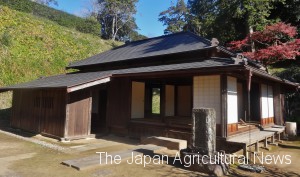Humanity guidance based on “Seigaku (Chinese Natural Science)”
At the end of Edo period of 1830s (Tempo year), Yugaku Ohara (1797-1858) , who worked hard as rural leaders for the reconstruction of the village exhausted by famine and others, started its activities in Nagabe village, Shimofusa country (Asahi City, Chiba Prefecture).
Born in the house of samurai of the Owari country (Aichi Prefecture), since being insulated from his father at the age of 18, he arrived at Boso area after wandering Kyoto, Osaka, Shinshu, and Edo. Meanwhile, he studied Confucianism, Divination lore, Buddhism, and Agricultural techniques.
At that time the domestic economy was facing a crisis. The Shogunate & clan system began to decline, and foreign countries forced Japan to open the country. Cold damage continued, and famine often occurred. Products and money economy also penetrated rural areas, and self-sufficiency economy was no longer hold.
The finance of the clan broke down, and the burden of the annual pension, the rampant of loan-sharking and the gambler caused the farmers to extreme poverty. Many houses, who could not repay debt, were forced to lose their ancestral land and live apart from birthplace village. Nagabe village is no exception. Ihei Endo, Myosyu, begged Yugaku for a rebuilding of the village.
Academic of Yugaku was called “Seirigaku (Chinese Natural Science)”, for short, “Seigaku”, affected by the Neo-Confucianism. It was the learnings at the time of Chinese Song Dynasty. It adopted the scriptures such as ” Book of Great Learning,” ” Book of Doctrine of the Mean,” ” Book of Analects”, and “Book of Filial Piety.” It is said that “Seigaku” is the meaning of “removing desire from people and bringing them closer to “Tenri (Law of Nature)”” (Kazuoki Ohno, “Hyakusho no gi (farmer ‘s righteousness)”). In the main work of Yugaku’s literature, “Bimiyugenko (Consideration of delicacy),” he emphasized that “considering morality aiming for the sustainability of family”.
Yugaku regularly lectured Seigaku to farmers and his disciples including women and children who were called “Doyu (Tao friend)”.
Seiichi Sugaya, Director & Secretary General of Yugaku Ohara Lore Association, whose five generations before ancestors was “Doyu”, thinks that Yugaku’s thought was “assimilation of Tendo (nature) and Jindo (humanitarian) “. He analyzes that his guidance policy was “Production instruction by human-nature interaction, and humanity guidance by social interaction between human beings”.
“Senzokabukumiai (ancestral share association)” to protect farmland
Yugaku’s lecture put emphasis on the debate. Their policy was ultimately decided at the meeting, but the meeting had four stages, i.e., Kashira-syukai (Head meeting, the highest executive meeting), Syo-zenya (Small eve, Executive Board), Chu-zenya (Middle eve (delegates conference), Dai-zenya (Large eve, the General Assembly). Its common name, “zenya (eve),” was attached since each stage meeting was convened on the eve of the meeting (Haruki Koshikawa, “Yugaku Ohara Research”). This system is reminiscent of the cooperatives of the modern.
Stacking of these discussions prevented the loss of farmland by the power of cooperation, and created the mechanism to sustain the subsistence farmers and maintain farmers families. It was “senzokabukumiai (ancestral share association)”, established in 1838 (Tenpo 9) at Nagabe village. 11 people invested initially, and then members increased to 25 people after.
Management method, which Doyu decided to each other, was as follows; 1) each Doyu invests 5 cars of arable land as 1 share, where profits earned from the fund had to be accumulated indefinitely, 2) until becoming equal to 100 cars per each house, the fund could not rescue any collapsed house, and 3) after becoming equal to 100 cars per each member house, the fund could rescue collapse house devoting the half of it, and the rest of it should be set aside for the sake of descendants.
On the other hand, Yugaku prohibited villagers’ joining to the Tanomoshiko (= Mujinko (mutual credit union)). He had cut off the villagers’ possibility to lose land again by debt.
The History of Yugaku Ohara
1797 March Yugaku is Reported to be born at Daidoji family in Owari Domain (Nagoya City).
1814 March Yugaku was insulated from parent and started a wandering life.
1814 February At Matsuoji temple, Ibukiyama, Ominokuni (Shiga Prefecture), Yugaku learned from Teiso, Chief Priest of the temple.
1830 March Received the encouragement of Priest Teiso again, Yugaku decided to practice of social movements.
1831 August Yugaku lectured at Ueda and Komoro, Shinsyu (Nagano Prefecture), his disciples increased. Yugaku went to Edo area and entered the Awanokuni (Awa country, Chiba Prefecture) by sea route via Uraga.
1835 August In response to the request of Ihei Endo, Myoshu (headman), Yugaku visited Nagabemura(Nagabe village) for the first time.
1838 September Yugaku formed the “senzokabukumiai (ancestral share association)” in Nagabe village
1841 February Yugaku executed “Bungo” (consolidation) and restructuring of arable land in Nagabe village
1842 September Ihei Endo, Myoshu (headman), provided residence to Yugaku.
1848 February Nagabe village was commended as a model village from lord
1850 April With increase of his disciples, Yugaku constructed instructor office, “Kaishinro”.
1852 April Agents of Kantotorishimarisyutsuyaku (Kanto area police agency) rushed into “Kaishinro”, and Yugaku was interrogated.
1857 October Yugaku received a judgment of 100 days “Oshikome” (detention)
1858 March 8 Early morning Yugaku committed suicide in Nagabe village cemetery. Yugaku was 62-year-old.
【Booklet】Beginning of Cooperatives <Yugaku Ohara ②> Collaborative purchase business(April 18, 2015)


